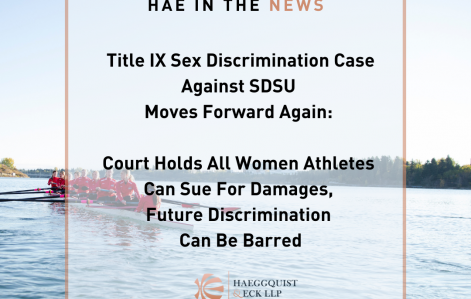Most employees in the U.S. know that the law prohibits sexual harassment at work. You might have an idea of what sexual harassment looks like, though it may take more forms than you realize. Some employees might not realize when someone sexually harasses them in one of these unfamiliar ways.
Below is some general information about types of workplace sexual harassment. If you believe someone sexually harassed you – or are unsure if they did – consult an sexual harassment attorney who handles sexual harassment claims immediately.
Schedule a Free Case Evaluation Today!
Harassment That Creates a Hostile Work Environment
Hostile work environment sexual harassment involves unwelcome sexual advances, comments, or conduct that create an intimidating, offensive, or hostile environment for an employee.
Various employment laws prohibit such conduct at work, including Title VII of the Civil Rights Act of 1964 at the federal level. Many states have additional laws prohibiting harassment, such as California’s Fair Employment and Housing Act (FEHA).
Here’s a look at what constitutes hostile work environment sexual harassment. An attorney can help you prove the necessary elements of sexual harassment to seek justice from your employer.
Overview
Hostile work environment sexual harassment occurs when the workplace environment becomes permeated with offensive sexual innuendos, jokes, comments, or advances that create a hostile or intimidating atmosphere for the employee. Overt behavior may consist of explicit comments or unwelcome touching, or more subtle, such as repeated inappropriate jokes or offensive images.
Unwelcome Conduct
The key element of hostile work environment sexual harassment is that the the recipient does not welcome or want the behavior. Consensual or welcome conduct may not meet the definition of harassment.
Severity and Pervasiveness
For harassment to create a hostile work environment, it must be severe or pervasive enough to alter the conditions of employment and create a hostile or abusive working environment. Isolated incidents or minor annoyances are generally insufficient to establish a hostile work environment claim.
Forms of Harassment
Hostile work environment sexual harassment can involve different conduct, including:
- Unwanted sexual advances or propositions.
- Sexually explicit or offensive comments or jokes.
- Displaying or sharing sexually suggestive or explicit materials.
- Making offensive or sexually charged gestures.
- Using sexually derogatory or degrading terms to describe someone.
- Insults, ridicule, or derogatory remarks based on an individual’s gender or sexual orientation.
- Sabotaging work or creating a hostile environment based on a person’s refusal of sexual advances.
Impact on Employees
Hostile work environment sexual harassment can have severe emotional and psychological consequences for victims. It can lead to anxiety, stress, depression, and a decline in job performance and job satisfaction. The fear of retaliation or the prospect of losing one’s job may also prevent victims from reporting the harassment.
Employer Liability
Employers can be liable for hostile work environment sexual harassment if they knew or should have known about the harassment and failed to take prompt and appropriate corrective action. Employers have a legal duty to provide a safe and respectful work environment and should have clear policies and procedures in place to address complaints of harassment.
There are also different ways someone can harass a victim to create a hostile work environment. These include:
Verbal Sexual Harassment
Verbal sexual harassment refers to unwelcome and offensive comments, remarks, or advances of a sexual nature that create a hostile or intimidating environment for the victim. This form of sexual harassment involves verbal communication and can occur in various settings, often workplaces.
Examples of verbal sexual harassment include:
- Sexual jokes
- Explicit comments
- Sexual propositions
- Sexually suggestive remarks
- Derogatory comments about an individual’s appearance or gender.
Verbal sexual harassment can be distressing, demeaning, and emotionally harmful to the victim.
Visual Sexual Harassment
This harassment involves unwelcome and offensive visual displays of a sexual nature that create a hostile or intimidating environment for the viewer. This form of sexual harassment involves explicit or suggestive images, videos, or gestures targeting a person based on gender or sexual orientation.
Examples of visual sexual harassment include:
- Displaying sexually explicit materials
- Sharing offensive images or videos
- Making lewd gestures
- Engaging in voyeurism
No employee should have to view harassing materials, gestures, or anything else while at work.
Physical Sexual Harassment
Physical sexual harassment involves unwelcome and inappropriate physical conduct of a sexual nature. This form of sexual harassment involves unwanted sexual contact, advances, or gestures that violate the recipient’s boundaries.
Examples of physical sexual harassment include:
- Touching
- Groping
- Grabbing
- Kissing
- Hugging
- Any other form of non-consensual physical contact of a sexual nature.
This is often one of the most obvious and intimidating types of sexual harassment at work.
Quid Pro Quo Sexual Harassment
Quid pro quo sexual harassment is a highly serious form of workplace discrimination. It happens when someone in a position of power conditions employment benefits or opportunities on the victim’s acceptance of unwelcome sexual advances or favors.
The term “quid pro quo” is Latin for “something for something,” reflecting the exploitative nature of this type of harassment. It occurs when a person with authority, such as a supervisor, manager, or company owner, uses their position to demand sexual favors or impose unwanted sexual advances on a subordinate or employee.
Key characteristics of quid pro quo sexual harassment include:
- Exchange of sexual favors – The harasser offers or implies they will grant certain employment benefits, such as promotions, raises, favorable work assignments, or job security, in return for the victim’s compliance with their sexual demands.
- Unequal power dynamic – Quid pro quo sexual harassment involves a significant power imbalance between the harasser and the victim. The harasser abuses their position of authority to pressure the victim into engaging in sexual activity or providing sexual favors.
- Unwelcome advances – The victim must reject or resist the sexual advances for it to be harassment. If the victim voluntarily enters into a consensual relationship with the harasser, it may not meet the definition of quid pro quo sexual harassment.
- Adverse consequences – If the victim refuses to comply with the harasser’s demands, they may experience adverse employment consequences, such as demotion, termination, loss of job opportunities, or retaliation.
Examples of quid pro quo sexual harassment in the workplace include:
- A supervisor threatens to fire an employee unless they engage in a sexual relationship with them.
- An employer promises a raise or promotion in exchange for the employee going on a date with them.
- A manager conditions a favorable work schedule on the employee accepting their sexual advances.
Quid pro quo sexual harassment is strictly against federal and state anti-discrimination laws. You can hold employers liable for quid pro quo harassment even if they did not have the chance to stop it.
Unlike hostile work environment harassment, employers do not require notice of the harassment and the opportunity to address the problem before liability attaches.
If one of your superiors engaged in this type of unlawful conduct, you should never wait to discuss what happened with a skilled sexual harassment attorney near you. A lawyer can provide the support you need, especially if you cannot trust your employer to help you.
Workplace Harassment Based on Sexual Orientation or Gender Norms
Not all workplace sexual harassment is sexually charged. Sometimes, harassment can revolve around someone’s sex, sexual orientation, gender expression, gender identity, gender nonconformity, and similar factors related to an employee’s sex and gender.
Workplace harassment based on sexual orientation or gender norms can create a hostile and toxic work environment for affected employees.
Sexual Orientation Harassment
This type of workplace harassment targets individuals based on their actual or perceived sexual orientation, including lesbian, gay, bisexual, and transgender (LGBT) individuals. Harassment can involve derogatory comments, slurs, offensive jokes, or other forms of verbal or written abuse.
Gender Norms Harassment
Gender norms harassment occurs when individuals face discrimination or mistreatment because they do not conform to traditional gender norms and expectations. This may include transgender individuals, gender-nonconforming individuals, or anyone who challenges traditional gender roles.
Impact on Employees
Workplace harassment based on sexual orientation or gender norms can have severe emotional, psychological, and professional consequences for victims. It can lead to anxiety, depression, reduced job satisfaction, and decreased productivity. The fear of discrimination or harassment may also deter qualified candidates from pursuing job opportunities or promotions.
Legal Protections
In California and across the United States, workplace harassment based on sexual orientation or gender norms is illegal under anti-discrimination laws, just like other forms of sexual harassment.
Title VII prohibits discrimination based on sex, which courts have specifically interpreted to include protection against discrimination based on sexual orientation and gender identity. Sexual orientation and gender identity are also express protections under FEHA in California.
Employers have a legal obligation to prevent and address workplace harassment based on sexual orientation or gender norms. This includes developing comprehensive anti-discrimination and anti-harassment policies, training employees and management regularly, and promptly investigating and addressing harassment complaints.
Employees who experience workplace harassment based on sexual orientation or gender norms should report it to their supervisor, human resources department, or other designated channels. Employers must take all complaints seriously and protect victims from retaliation.
When employers fail to take the necessary steps to protect the rights of employees and harassment persists, employees have the right to hold their employers liable for the harm they suffered.
What to Do if You Suffered Sexual Harassment at Work
If you have experienced sexual harassment at work, you should never hesitate to take action to protect your rights, well-being, and professional environment.
Below are some steps to consider if you have suffered any form of sexual harassment.
When unsure what to do, never delay seeking guidance from an employment law attorney.
- Consult an employment attorney – Always seek legal advice from an experienced employment attorney who handles sexual harassment cases. They can help you understand your rights, options, and potential legal recourse.
- Document all incidents of harassment – Write down detailed accounts of each incident, including dates, times, locations, and any witnesses present. Keep any physical evidence, such as offensive messages or notes.
- Review your workplace policies – Your lawyer can explain your company’s policies on sexual harassment and reporting procedures. These policies should outline the steps you should take if you experience harassment.
- Report the harassment – Your lawyer can help you report the incidents to your supervisor, manager, human resources department, or any other designated authority, following your company’s reporting process. Make your report in writing if possible, and keep a copy for your records.
- Keep records of retaliation – If you experience any form of retaliation after reporting the harassment, document these incidents as well. The law prohibits retaliation for reporting sexual harassment, and you might need to take further legal action.
How a Sexual Harassment Lawyer Can Help You
Experiencing sexual harassment can be emotionally devastating, especially if it affects your job and career path. This is a difficult situation whether you are still working at your job, were fired for noncompliance with sexual requests, or felt you had to quit due to a hostile work environment.
In any of these situations, an employment attorney can provide the following services, among others:
- Objectively assess what happened and whether the conduct you experienced was sexual harassment
- Identify your legal rights according to the type of harassment you experienced
- Negotiate with your employer to attempt to resolve the matter without filing a formal complaint
- If your employer is not willing to provide legal relief, your lawyer can file the appropriate complaints with state or federal government agencies
- Provide evidence to support your claims and challenge any defenses your employer tries to present
- Determine how much you deserve in compensation for the emotional, financial, and professional harm you suffered
- File a case in civil court if necessary
No matter what type of harassment you suffered, you should exercise your legal rights to hold your employer accountable under the law. Doing so can help you move forward with greater support and a sense of justice for what happened to you. Seek help from a skilled employment attorney today.





